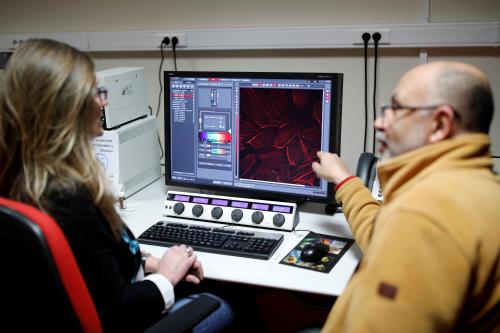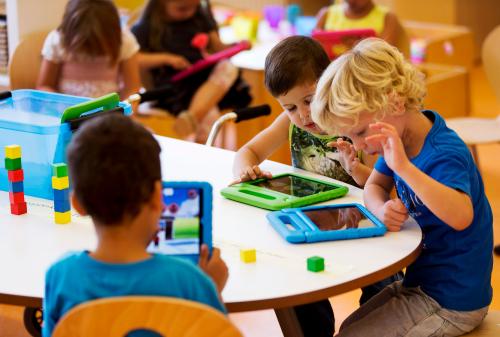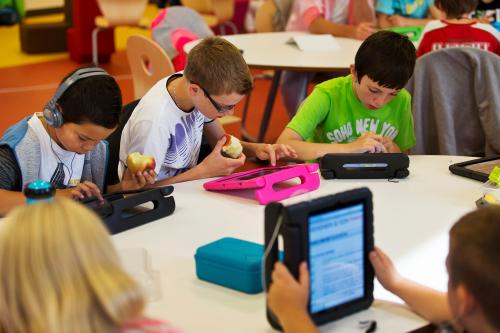I’ll bet you’ve read something about technology and learning recently. You may have read that device use enhances learning outcomes. Or perhaps you’ve read that screen time is not good for kids. Maybe you’ve read that there’s no link between adolescents’ screen time and their well-being. Or that college students’ learning declines the more devices are present in their classrooms.
If ever there were a case to be made that more research can cloud rather than clarify an issue, technology use and learning seems to fit the bill. This piece covers what the research actually says, some outstanding questions, and how to approach the use of technology in learning environments to maximize opportunities for learning and minimize the risk of doing harm to students.
The good
In my recent posts, I have frequently cited the mixed evidence about blended learning, which strategically integrates in-person learning with technology to enable real-time data use, personalized instruction, and mastery-based progression. One thing that this nascent evidence base does show is that technology can be linked to improved learning. When technology is integrated into lessons in ways that are aligned with good in-person teaching pedagogy, learning can be better than without technology.
A 2018 meta-analysis of dozens of rigorous studies of ed tech, along with the executive summary of a forthcoming update (126 rigorous experiments), indicated that when education technology is used to individualize students’ pace of learning, the results overall show “enormous promise.” In other words, ed tech can improve learning when used to personalize instruction to each student’s pace.
Further, this same meta-analysis, along with other large but correlational studies (e.g., OECD 2015), also found that increased access to technology in school was associated with improved proficiency with, and increased use of, technology overall. This is important in light of the fact that access to technology outside of learning environments is still very unevenly distributed across ethnic, socio-economic, and geographic lines. Technology for learning, when deployed to all students, ensures that no student experiences a “21st-century skills and opportunity” gap.
More practically, technology has been shown to scale and sustain instructional practices that would be too resource-intensive to work in exclusively in-person learning environments, especially those with the highest needs. In multiple, large-scale studies where technology has been incorporated into the learning experiences of hundreds of students across multiple schools and school systems, they have been associated with better academic outcomes than comparable classrooms that did not include technology. Added to these larger bodies of research are dozens, if not hundreds, of smaller, more localized examples of technology being used successfully to improve students’ learning experiences. Further, meta-analyses and syntheses of the research show that blended learning can produce greater learning than exclusively in-person learning.
All of the above suggest that technology, used well, can drive equity in learning opportunities. We are seeing that students and families from privileged backgrounds are able to make choices about technology use that maximize its benefits and minimize its risks, while students and families from marginalized backgrounds do not have opportunities to make the same informed choices. Intentional, thoughtful inclusion of technology in public learning environments can ensure that all students, regardless of their ethnicity, socioeconomic status, language status, special education status, or other characteristics, have the opportunity to experience learning and develop skills that allow them to fully realize their potential.
The bad
On the other hand, the evidence is decidedly mixed on the neurological impact of technology use. In November 2016, the American Association of Pediatrics updated their screen time guidelines for parents, generally relaxing restrictions and increasing the recommended maximum amount of time that children in different age groups spend interacting with screens. These guidelines were revised not because of any new research, but for two far more practical reasons. First, the nuance of the existing evidence–especially the ways in which recommendations change as children get older–was not adequately captured in the previous guidelines. Second, the proliferation of technology in our lives had made the previous guidelines almost impossible to follow.
The truth is that infants, in particular, learn by interacting with our physical world and with other humans, and it is likely that very early (passive) interactions with devices–rather than humans–can disrupt or misinform neural development. As we grow older, time spent on devices often replaces time spent engaging in physical activity or socially with other people, and it can even become a substitute for emotional regulation, which is detrimental to physical, social, and emotional development.
In adolescence and young adulthood, the presence of technology in learning environments has also been associated with (but has not been shown to be the cause of) negative variables such as attention deficits or hyperactivity, feeling lonely, and lower grades. Multitasking is not something our brains can do while learning, and technology often represents not just one more “task” to have to attend to in a learning environment, but multiple additional tasks due to the variety of apps and programs installed on and producing notifications through a single device.
The pragmatic
The current takeaway from the research is that there are potential benefits and risks to deploying technology in learning environments. While we can’t wrap this topic up with a bow just yet–there are still more questions than answers–there is evidence that technology can amplify effective teaching and learning when in the hands of good teachers. The best we can do today is understand how technology can be a valuable tool for educators to do the complex, human work that is teaching by capitalizing on the benefits while remaining fully mindful of the risks as we currently understand them.
We must continue to build our understanding of both the risks and benefits as we proceed. With that in mind, here are some “Dos” and “Don’ts” for using technology in learning environments:
| Do use technology: | Don’t use technology: |
|
● To enhance or extend social interactions
● To provide access to learning environments (like advanced courses, simulations, etc) that otherwise would not be available ● To facilitate and generate learning experiences that are meaningfully aligned with in-person learning experiences ● To personalize, individualize, and/or differentiate learning to each student’s pace, path, abilities, and interests ● To provide students with choice, agency, and ownership of their learning ● To ensure equitable access to technology and its supporting infrastructure itself, as well as the opportunity to develop skills associated with technology use |
● For many or unlimited hours each day
● To remove students from learning experiences that their peers have access to ● To implement, scale, or sustain ineffective in-person instructional strategies ● To track or stream students into rigid or long-term, standardized learning groups ● To automate or make decisions about learning without input from teachers and students ● With the assumption that students intuitively know how to use it (or have access to it), especially for learning |
The Brookings Institution is committed to quality, independence, and impact.
We are supported by a diverse array of funders. In line with our values and policies, each Brookings publication represents the sole views of its author(s).







Commentary
Is technology good or bad for learning?
May 8, 2019